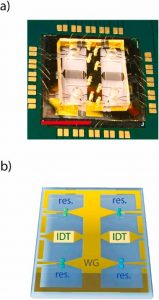Glial-fibrillary-acidic-protein (GFAP) has recently drawn significant attention from the clinical environment as a promising biomarker. The pathologies which can be linked to the presence of GFAP in blood severely affect the human central nervous system. These pathologies are glioblastoma multiforme, traumatic brain injuries, multiple sclerosis, intracerebral hemorrhage, and neuromyelitis optica. Researchers @NEST developed three different detection strategies for GFAP, among the most popular in the biosensing field and never examined side by side within the experimental frame. The best-performing protocol was integrated in an ultra-high-frequency (UHF) surface-acoustic-wave (SAW) based lab-on-chip (LoC) previously developed @ NEST. GFAP successful detection was demonstrated in serum-matrix at a concentration compatible with clinical diagnostics. This result suggests the use of our technology for the realization of a point-of-care biosensing platform for the detection of multiple brain-pathology biomarkers.

“Glial-fibrillary-acidic-protein (GFAP) biomarker detection in serum-matrix: Functionalization strategies and detection by an ultra-high-frequency surface-acoustic-wave (UHF-SAW) lab-on-chip.” M.Agostini, F.Amato, M.L.Vieri, G.Greco, I.Tonazzini, L.Baroncelli, M.Caleo, E.Vannini, M.Santi, G.Signore, and M.Cecchini, Biosensors and Bioelectronics 172, 112774 (2020) [if 10.3]
